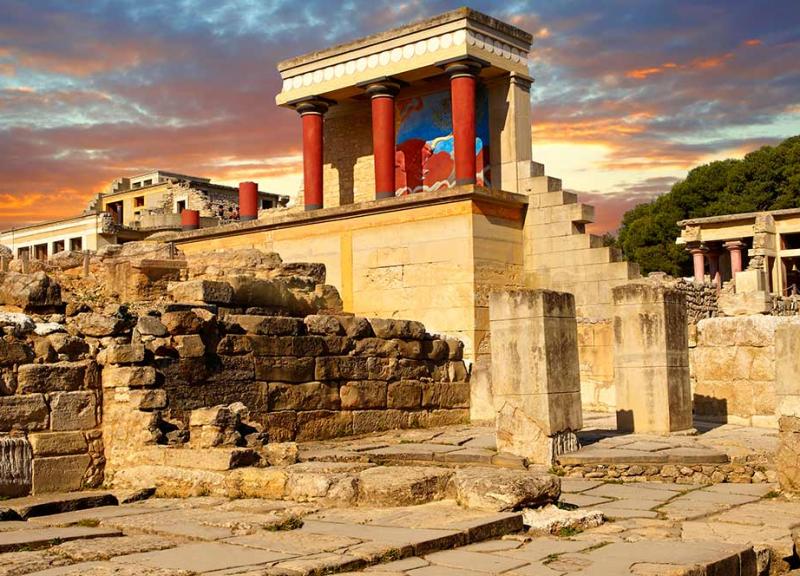Knossos Palace
The palace of Knosso dates back to the Bronze Age and is part of the great Minoan civilization.
It is the largest of the preserved Minoan palatial centres, built in 2000 BC. In the four wings arranged around the central courtyard, wou will see the royal quarters, workshops, shrines, storerooms, repositories, the throne room and banquet halls.
Knossos was the prosperous Minoan Capital and the residence of King Minos. Some believe that the intricate Palace with its many rooms was the mythical labyrinth.
By discovering the site not too long ago, archaeologists found the first of all advanced civilizations in Europe.
The Minoan Civilization:
The Minoan civilisation flourished in the Bronze Age between 2,700 and 1,600 B.C. not only in Crete but also on other Aegean islands. The name Minoan derives from the mythical king of Crete, Minos, who according to the legend has built the labyrinth with the monster Minotaur inside it. This civilisation is famous all over the world for its magnificent palaces, decorated with frescoes. The most notable palaces are Knossos and Phaistos. The Minoan cities were also well-advanced with roads, water and sewage facilities through pipes. Buildings with flat, tile roofs and walls made of stone.
The influence of the Minoans reached the whole Mediterranean Sea including the Cyclades, Egypt, Cyprus, Canaan and Anatolia. They wrote in one of the oldest scriptures in Europe, the Linear A, which has not been deciphered yet. The Disc of Phaistos is a clay tablet with signs and words of the Linear A and is exhibited in the Archaeological Museum in the town of Heraklion.
Archaeological Museum of Heraklion
After that, you will get to the archaeological museum of Heraklion and you will admire close murals and objects from the palace you have just visited.
It is one of the greatest museums in Greece and the best in the world for Minoan art, as it contains by far the most important and complete collection of artefacts of the Minoan civilization of Crete.The Archaeological Museum, that is located in the town centre, invites you on a trip back into 5,500 years of history. Among the Museum’s exhibits, you will see items dating to Cretan prehistory and history, from the Neolithic Age to the Roman times. Most of them date to the Minoan Period and they involve works of ceramic art, stone carving, seal engraving, micro-sculpture, metal crafting and painting found in palaces, edifices, settlements, tombs, temples and caves.
The colours and construction materials, such as the veined polychrome marbles, recall certain Minoan wall-paintings which imitate marble revetment.
Herakleion Old Town
Heraklion is a seaside city in Crete that embraces both past and present.
Take a short walk to the city center of Heraklion, the vibrant capital of Crete, a place where you can feel the vibes of modern life and travel back in the Venetian and Ottoman period by walking among the ancient monuments.
The vibrant city compines squares and pedestrian walkways and it is filled with restaurants and bars, but so much of its charm still concentrates around the Old Town and its romantic Venetian harbour.
You will have time to visit the market, the shops and have lunch and a visit to the Venetian port of Heraklion and the old castle Koules, which is built on two tiers and offers a commanding view of Heraklion from the battlements.
Walking in the old town, you will reach St. Titus’ Cathedral, an impressive sight and Loggia, a wonderful example of a Venetian building.











 Your tour starts with a visit to the
Your tour starts with a visit to the 
 Lastly, will be the time for you to discover the
Lastly, will be the time for you to discover the 